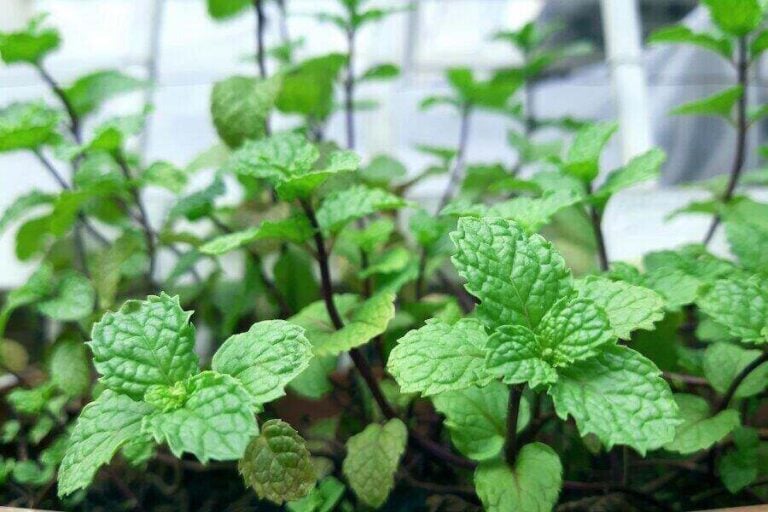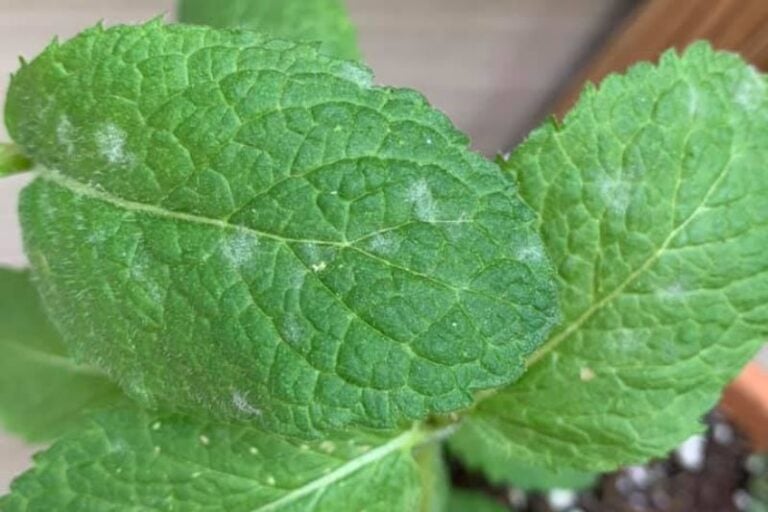
Mint plants are associated with freshness. Their leaves are great to use in a variety of culinary dishes, as well as in tasty drinks like teas and Mojitos.
Therefore, it can be really disheartening when you see that your beloved plant is turning from vibrant green to an unfamiliar purple.
There are several reasons why mint leaves turn purple, read on to find out how to keep your lovely plant looking green and healthy!
The main reason that mint leaves turn purple is that they are planted in soil which lacks phosphorus. Bone meal or fertilizer can be used to increase phosphorus levels. Another common cause of mint turning purple is overwatering. Mint plants don’t need a lot of water to survive and it can be easy to be over-generous with them.
Mint plants are relatively low-maintenance, and after identifying what’s got yours into a purple funk it should be easy to rectify the problem.
Let’s take a look at the possible causes for the leaves turning purple and get your plant back to its vibrant green self in no time.
Contents
Causes of Mint Leaves Turning Purple
Below you will find a variety of potential causes for those unwanted purple leaves, all of which are easy to solve.
No need to despair, I’ve got you covered with ways to fix all of the following problems!
Lacking Nutrients
Mint enjoys rich soil with a pH between 6.0 and 7.0. It requires a good level of phosphorus, nitrogen, and potassium.
Cold soil, or soil which is too wet, can stop plants from being able to properly absorb nutrients.
Therefore, sometimes even when the nutrients are present, the plant just isn’t able to benefit from them!
Other factors that might stop your mint from being able to absorb precious nutrients could include high soil acidity and too much iron in the soil.
A nutrient deficiency will result in a plant that is struggling to survive, and this will show through changes in its size and ability to maintain leaves, as well as in the color and health of the leaves themselves.
Source: Taylor and Francis Journals
How to fix a lack of nutrients
You can offer your minty friend a nutritious helping hand by performing a soil analysis.
If the phosphorus levels are low, you can raise them by adding bone meal, compost, or manure.
Make sure that the conditions of the soil are allowing your mint plant to properly benefit from the nutrients!
Check that you are not overwatering your plant and move it to a warmer location if the soil is too cold.
If the pH of the soil is too low, raise it by using lime. Keeping the pH of the soil between 6.0 and 7.0 will also keep iron levels optimal.
Source: College of Agriculture and Life Sciences- The University of Arizona
Overfertilization
Using a lot of fertilizer might seem like a sure-fire way to take care of your mint plant.
Unfortunately, there can be too much of a good thing. Excessive fertilizer usage can cause notable problems.
Too much fertilizer can make a plant grow rapidly, but its roots do not grow fast enough to compensate.
As a result, the plant suffers because the roots are unable to sufficiently supply the whole plant with water and nutrients.
The upshot of this is that you are left with a plant lacking in vitamins and minerals, otherwise known as a rather unhappy plant!
Mint is likely to react badly to this shortage of nutrients and may exhibit symptoms such as darkening or purple leaves.
It will also lead to your mint plant becoming less aromatic, which of course we want to avoid at all costs!
How to Fix Problems With Overfertilization
If your plant is overfertilized, there are a few easy fixes. Firstly, stop fertilizing your plant immediately! Leave it at least a month until you consider giving it any more food.
If you can see fertilizer in the soil, take it out to instantly limit the amount of fertilizer available to your mint plant. Remove any damaged leaves or stalks to allow your plant’s roots to effectively nourish the rest of the plant.
Source: UCCE Master Gardeners of El Dorado County
Sunburn
Mint is not well known for being a sun-worshipper. Whilst it likes a bit of light, placing your mint plant in strong, direct sunlight is a recipe for an unhappy plant.
If you’re able to keep the soil moist through a regime of frequent watering, it may manage to survive in a sunny spot.
However, mint plants prefer to be in partial shade. Unlike most culinary herbs, mint thrives in shaded areas.
Sunburnt plants struggle to keep their natural green hue, often turning dark and brittle as a result of the damage they have endured.
How to Fix a Sunburnt Mint Plant
Choose a position near a sunny window for your mint plant, but make sure it isn’t sitting in direct sunlight for hours on end.
Ensure that it’s getting a good amount of water if it is exposed to the sun.
Keep an eye on how the sunlight changes during the year, you may need to move your plant during certain months if it is suddenly getting too much sunlight.
Insufficient Light
Whilst I’ve already mentioned that mint plants can crisp up and struggle in the sun, it’s also important not to rob them of light altogether. A dark corner of the house will not help those leaves stay green for long.
Without any light, plants are unable to carry out photosynthesis. This biological process helps keep leaves green. No sun, no green leaves!
How to Fix Lighting Problems
Keep mint plants in light rooms and away from poorly lit enclaves and shadowy spaces.
Again, it may be necessary to switch up your plant’s location every now and then, to make sure it’s not getting left in the dark!
If you don’t have an ideally lit location, you could even consider moving your mint plant into a lighter space during the daytime and placing it back in its usual spot in the evening.
It is also worth bearing in mind that artificial lamps can be used to help plants thrive in places that don’t get enough sunlight.
Lamps designed specifically for growing plants could be a good option!
You May Also Enjoy: Why Are My Mint Leaves Turning Black? (Causes and Solutions)
Overwatering or Underwatering
Like many plants, mint needs a good amount of water but not too much. It can be easy to suddenly load water onto your mint plant, especially if you may have forgotten to water it for a few days.
Unfortunately, this has the effect of overwhelming the plant and flushes precious nutrients from the soil.
Too much water over a prolonged period could even lead to rotting roots. Yikes!
If the soil is too dry, water is not able to make it into the mint’s root system and again it will struggle to get the nutrients it needs.
This will result in your poor mint feeling dried out and parched.
A lack of nutrients, caused by overwatering or underwatering, is sure to cause your plant significant problems.
The mint will struggle to sustain itself, and its extremities (its leaves!) will be the first things affected. Often, they will change color, shrivel, or fall off.
How to Fix Overwatering or Underwatering
The soil of your mint plant should be moist, but not wet. If the soil at the top appears squidgy, it’s likely you’re overwatering your plant.
A good way to check the moisture levels below the surface is to push your finger into the soil a short way. Again, it should be moist – not wet and not dry.
Avoid pouring water directly onto the leaves of the plant as this can also directly damage them.
You May Also Enjoy: Why Is My Mint Turning Brown? (And How to Fix It)
Poor Drainage
Mint plants need to be planted in pots that can drain well. In nature, they are often found on the banks of streams, a location which provides them with great natural drainage.
In the home, we don’t tend to have the facilities to imitate this natural drainage system. But we can make sure that the pots we use for our mint plants come close.
The challenge is that mint loves moisture, but without proper drainage the roots will rot and the plant’s health will deteriorate.
This will cause changes to the pigmentation of the leaves and make the plant generally weaker.
How to Fix Problems with Draining
Not all soil is made equal, and some does not drain as well as others. Make sure to use a mixture of soil and sand, or perlite, to improve drainage in your plant pot.
Pots should have drainage holes at the bottom and be relatively large, at least 10 inches (25.5 cm) deep.
Insect Infestation
Insects can be pesky little troublemakers when it comes to maintaining the health of your mint plant.
Spider Mites, Thrips, and Aphids all love to make themselves at home on the leaves of your favorite herb.
Whilst this may be pleasant for them, it certainly doesn’t do your mint’s health any favors.
The insects’ tendencies to feed off plants mean that they rob your mint of vital nutrients, often leading to decolorization of the leaves and generally poor health.
How to Fix Insect Infestation
Plant-based insecticides can be a valuable tool in removing unwanted guests from the leaves of your mint plant.
They have the added bonus of not damaging the plant itself. Consider using rosemary oil or garlic water.
Applying rubbing alcohol to your plant can kill unwanted pests, but it’s quite drying so use caution.
Sometimes simply spraying the plant with water can be enough to banish troublesome critters.
Temperature Changes and Time of Year
Although these factors may not affect house plants as much as those planted outdoors, changes in temperature and the time of the year can still impact the health and appearance of your plants.
Mint plants like a temperature between 55 and 70°F (13-21°C). In the cold and winter months, your plants might feel the chill just as much as you do, making them unable to process the nutrients in the soil as efficiently.
Equally, in high temperatures and during the hot summer they may suffer from wilting and drying out.
Either one of these scenarios could result in the leaves of the plant being affected and changing color.
How to Fix Temperature Problems
Keep an eye on temperatures to see if they drop below 55°F (13°C) or rise above 70°F (21°C).
If it’s cold, consider moving your plant away from draughty windows and doors and putting it in a warmer room.
If necessary, a small indoor heater can be used to raise temperatures, but make sure not to put it too close to your prized plant.
Similarly, if it’s too hot, give your mint a chance to cool down by moving it to a colder area.
It can be a good idea to keep windows closed during the day (shutting hot air out) and open them at night to let fresher air in.
Conclusion
There’s no need to panic if the leaves of your wonderful mint plant are turning purple. Following the advice above will get your plant fit again in no time!
Have you had problems with your mint leaves turning purple? What did you do to beat the problem?






